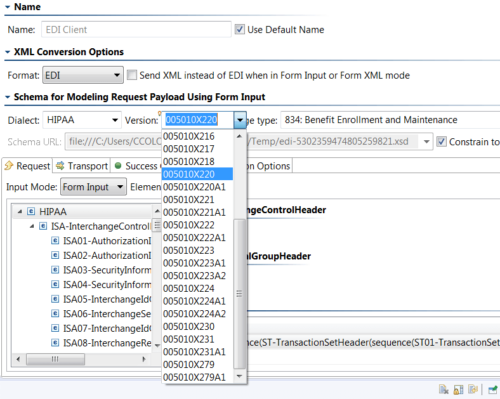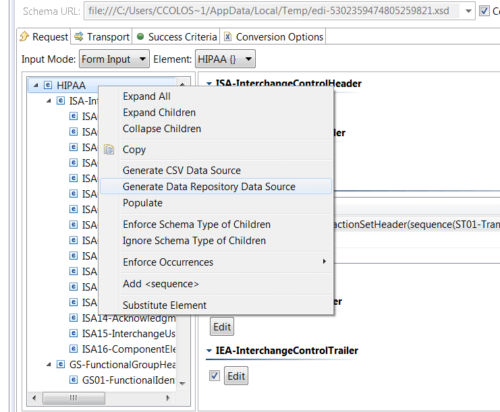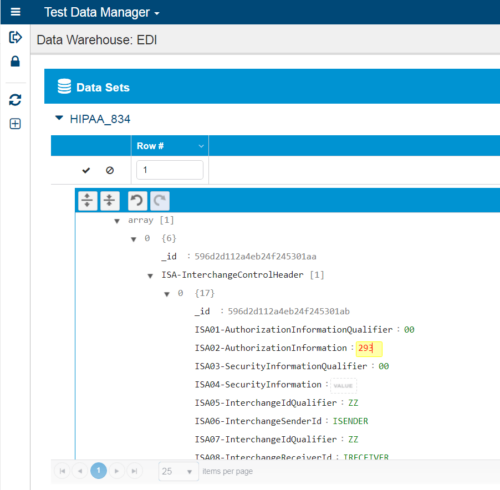Use Agentic AI to generate smarter API tests. In minutes. Learn how >>
What Is EDI & How to Manage Complex, Hierarchical Data
Working with EDI presents several difficulties for testers. This article explores how automated testing might help you handle these difficulties.
Jump to Section

Working with EDI presents several difficulties for testers. This article explores how automated testing might help you handle these difficulties.
While helping with functional test automation deployments at two different health insurance providers, the Parasoft team discovered some commonalities in their challenges stemming from EDI data.
This blog post digs into these challenges that testers face when working with EDI, and how you can start to solve them with automated testing.
First, let’s go back to the basics. EDI is a message format standard used to communicate business information between business entities. In the past, businesses used paper for transactions like purchase orders, invoices, and, in the healthcare industry, enrollment forms. This traditional working approach was complicated and prone to error.
To improve on the process, EDI was designed to standardize communications and make a "paperless exchange."
Although EDI improved the process by allowing companies to send information electronically rather than with paper, EDI also brought along its own challenges. Parasoft helps teams solve these problems with our software testing solutions. Let’s dive into what EDI testing is and then explore automated testing solutions.
EDI testing is the process of verifying that EDI transactions are accurate, complete, and conform to the required standards and specifications. It involves testing the various components of an EDI transaction, such as the message structure, data elements, segment values, and transport protocol, to ensure that they meet compliance standards. EDI standards are predetermined guidelines for organizing information within EDI documents, and these standards dictate how businesses should handle specific data types within the document.
Since EDI transactions involve a large amount of data, which can be prone to errors and omissions, carrying out EDI testing helps to bring about accuracy, consistency, and completeness in EDI documents.
Apart from helping organizations identify and eliminate errors in their electronic data, EDI testing also ensures that businesses get their EDI certification process right. Being EDI certified is usually where many suppliers encounter challenges as there must be proof of compliance with specific standards, such as HIPAA, for healthcare-related businesses and PCI DSS for the payment card industry.
EDI certification is the process of verifying that a company’s EDI transactions meet the required standards and specifications. It’s often required by trading partners as a prerequisite for doing business and assures trading partners that a company can securely and reliably exchange electronic data.
To obtain EDI certification, a company must demonstrate its ability to send and receive EDI transactions accurately and efficiently. The certification process typically involves a series of tests designed to validate the company’s EDI capabilities. These tests may be performed by the trading partner or a third-party certification organization.
The certification process may involve testing several aspects of EDI, such as message structure, data elements, and segment values. The company must demonstrate that it can handle diverse types of transactions, such as purchase orders, invoices, and shipping notices, and that it can handle errors and exceptions effectively.
Passing EDI testing is essential for companies that want to work with trading partners who require EDI compliance. To pass EDI testing, businesses must follow a set of best practices that ensure that their electronic documents are accurate, reliable, and conform to industry standards.
In many situations, companies require their trading partners to prove they can transact with them according to their EDI requirements. For instance, Amazon has specific EDI document standards, such as ANSI X12 and EDIFACT. Suppliers, depending on the Amazon channel they trade, must meet these requirements before they can do business with Amazon.
Below are some tips that can help businesses pass EDI testing.
Before you start the EDI testing process, it’s essential to understand the EDI standards that your trading partners require. EDI standards differ based on the industry and the type of transaction. For example, the HIPAA EDI standards govern electronic transactions in the healthcare industry, while the EDIFACT standards are more prevalent in the commercial, export and transportation industries. Therefore, it’s crucial to familiarize yourself with the specific standards your trading partners require to ensure you can pass EDI testing.
Validating your electronic documents is a critical step in passing EDI testing. EDI documents must be error-free and conform to the EDI standards. You can use EDI validation software or tools provided by your trading partners or a third-party EDI software solution to validate your electronic documents. These tools can test your EDI transactions to ensure that your electronic documents meet the necessary standards. To make for a seamless validation of EDI documents, it’s important to communicate with your trading partners to ensure that you understand their requirements and expectations.
While some organizations can use their in-house team to test for EDI compliance, working with an EDI testing provider like Parasoft can make the EDI testing process faster and more efficient and demonstrate commitment to expertise. With Parasoft solutions, such as SOAtest and Virtualize, your EDI testing is simplified because our solutions can help you:
We can also provide ongoing support and maintenance to ensure that your EDI transactions continue to meet the necessary standards.
While there are predefined standards for testing and meeting EDI document requirements for different industries, defining an EDI testing strategy for your organization is important if you want to achieve comprehensive and thorough EDI testing.
Below are some tips for developing an effective EDI testing strategy for your organization.
EDI testing is essential for any business that engages in electronic transactions with its trading partners. Here are some of the business needs for EDI testing.
Ensures compliance. EDI testing ensures that your organization is complying with industry standards and regulations, such as those set by HIPAA, FDA, and other regulatory bodies. Compliance with these standards is necessary to avoid legal and financial penalties.
Ensures error-free transactions. EDI testing ensures that your organization sends and receives error-free transactions, which can help prevent costly errors and delays. This is especially important in industries where time-sensitive transactions occur, such as healthcare and retail.
Facilitates efficient communication. EDI testing ensures that your organization’s communication with trading partners is efficient and effective. Testing helps to identify and address communication issues, such as delays, misinterpretations, or missing information.
Improves relationships. EDI testing helps to build better relationships with trading partners by ensuring that communication is accurate, efficient, and error-free. This can lead to improved trust, increased productivity, and long-term partnerships.
Competitive advantage. EDI testing can give your organization a competitive advantage by allowing you to conduct business more efficiently, accurately, and reliably than your competitors. This can result in increased customer satisfaction, reduced costs, and improved profitability.
For the healthcare deployments mentioned at the top of this post, Parasoft worked with organizations that were using HIPAA standard message definitions to generate 834 files as both requests and responses. These payloads were a fixed length and very complex.
For both teams, they needed to send and receive files for testing. Since they didn’t have a way to drive the actual EDI message into the system, they had to use physical files. They would receive an email that had the definition of the file, drop that file into the exchange folder, and then manually validate the results that came back.
The data was pre-created and put into the proper format in the file, but they didn’t have an easy way to alter it. It was difficult to get the appropriate data into the system and drive the validations with the same data source.
In these deployments, the Parasoft team added SOAtest and Virtualize to their workflows. Through message packs, our solutions could provide a library of such definitions that could be generated on demand. This way, both teams were able to produce the necessary messages and, more importantly, data-drive the requests and responses when sending a request and when validating the response.
Using SOAtest and Virtualize, we also improved how the health insurance providers were dealing with hierarchical EDI. The data repository seamlessly handled hierarchical data, allowing them to create data structures that were easy to interact with and could be used for both requests and validations—an exciting solution for those who use EDI with file data sources!
Let’s highlight the benefits of automating EDI testing, and then walk through the workflow we put in place to solve the challenge, so you can do it too.
EDI test automation involves using specialized software tools to automate the testing of EDI messages and transactions. EDI testing software is designed to simulate the EDI transactions between two or more trading partners, ensuring that the data is correctly formatted, transmitted, and received without errors. The software typically includes features for testing the syntax and structure of EDI messages and verifying that they conform to specific standards and protocols, like EDIFACT and ASC X12.
EDI testing software also allows you to simulate various scenarios and exceptions that may occur during EDI transactions, such as missing data, incorrect data, or data in the wrong format. As a result, it helps to ensure that the system can handle different situations and that the data is accurate and consistent across different systems.
One of the main features of EDI software solutions is that they automate EDI testing tasks that would take humans hours or even weeks to carry out. By automating the testing process, teams can reduce the time and effort required to perform manual testing, especially for businesses with large volumes of EDI transactions.
EDI test automation offers several key benefits for businesses that rely on business-to-business (B2B) transactions. Some of these benefits include:
How do you automate your EDI testing using a solution? The below instance shows how SOAtest makes EDI testing more efficient
The starting point for this example was the included EDI message schema for an 834 file. Employing SOAtest makes it easier to work with EDI because SOAtest contains a library of these built-in messages. Here’s how it works.
Choose the message Dialect, Version, and Type from dropdowns. The payload instantly shows up and is ready to drive with data. Next, fill in a few values for the default message. These can be the data values that won’t change.

Instantly create a Hierarchical Data source for the payload directly from the Editor. No need to map the response elements to the payload because it’s all done automatically. This will generate a data source that’s easy to work with.

Once that data source is created, add, remove, and alter the data just like working with a spreadsheet. The data is represented in Virtualize’s thin client interface. Here’s what the data editor looks like in the Test Data Manager.

That completes the seamless workflow to take you from EDI definition to an intuitive data source. This allows teams to get to the validation pieces that they may have struggled with. They can easily add new use cases to the data source and drive validations from them.
For the health insurance providers, we were able to send the calls directly into the system using HTTP but simulate the file drop by transforming the output to a file, placing the form in the proper folder, and setting up the file listener to receive the response.
Having a functional testing tool that works for you instead of against you can make a huge difference when you have a complex message format or protocol to contend with. When we deploy Parasoft SOAtest and Virtualize, it takes the guesswork out of working with complex, legacy, or uncommon use cases. All the test cases and simulated services you create with EDI messages seamlessly fit into your existing test design paradigms, saving you a significant amount of time.
For companies struggling to test EDI messages, adopting the Parasoft SOAtest and Virtualize solution can help your team configure, send, and validate any text-format message through an easy-to-use platform.
SOAtest is an excellent choice for businesses that need to test various native document formats and supports a wide scope of tools that can perform sophisticated validation of EDI messages.
Using EDI or a different industry-specific message format?
Get key insights on testing transactions involving EDIFACT, HL7, HIPAA, X12, and other message formats.